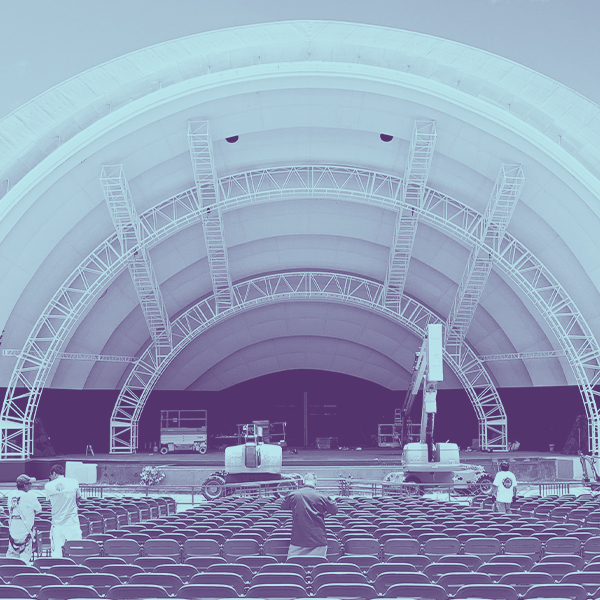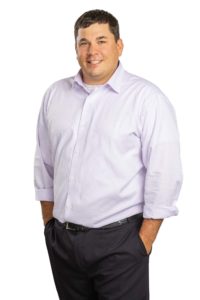Originally published in the August 2023 issue of STRUCTURE magazine
The development of the International Building Code 2024 for temporary structures goes a long way toward defining the criteria that engineers should use in design. It provides design loads and operational management plans that both the building official and structural engineer can agree on and acknowledges that performance-based criteria for a structure with a limited duration can be achieved safely. The proposed Code has also referenced the operational management plan and inspection criteria specified in ANSI E1.21-2020, “Temporary Structures Used for Technical Production of Outdoor Entertainment Events.” While it is the best of both worlds, it is only one piece of the puzzle.
Temporary structures and their production, installation, and design involve multiple parties and organizations to put on a show. On-site personnel and engineers must work together so that operational procedures and loading on the structure have been addressed. We rely upon structural design theory and communication by on-site personnel for the public’s safety around these structures.
Types of temporary structures
Stages take many forms and sizes, from large steel structures to lightweight aluminum box truss structures that can be required to support 30 to 50 tons of rigging equipment.
Mobile stages
Mobile stages can offer a unique design-build type strategy that can drive right to the venue and unfold before your eyes (See Figure 1). These mobile stages are pulled behind a truck or semi and open up into stages that can be 50 feet wide and up to 40 feet tall. Hydraulics are typically used to open the stages with guy wires and locking pins installed after deployment. The chassis and structure self-weight, along with additional ballast, if necessary, are used to resist sliding and overturning loads.
Concert stages
Temporary structures for concert venues can be erected and disassembled every 1 to 2 weeks throughout the spring, summer, and fall. These structures are assembled, raised into position, lowered, and placed on a truck to travel to the next show.
Large stage roofs are typically erected on the ground and hoisted into place using a pulley system attached to the tops of the truss columns. The motor attaches to the structure’s base, and the lift line wraps over two pulleys at the top of the truss. It then connects to the fully assembled roof structure. The roof structure, supporting only its self-weight, is lifted into place, locked out, and ready to support the show loads.
ANSI E1.21 Operation Management Plans (OMP)
An operation management plan (OMP) is a key tool required for each show. The OMP is the engineer’s way of communicating safety-related action items to the on-site personnel for environmental loading.
To reduce environmental loading on the structure, operation management plans, defined by ANSI E1.21, allow for mitigating actions to be taken by the designated qualified person on site. Weather with high wind speeds exceeding 40 to 50 miles per hour (mph) does not occur frequently, but the potential for winds of this magnitude can be forecasted ahead of time. The updated IBC recognizes that these gusts can occur during a weather event, and a plan can be implemented to reduce wind loads on these structures. Therefore, it makes sense to provide performance-based criteria that allow for a reduction in design loads during the normal operation of a show. Have you ever been in a storm that generated 40 to 50-mph winds? If you have, hopefully, you were near a permanent structure. It would be impractical for an outdoor show to go on, and the OMP allows for this practical event scenario. People can be evacuated from the area, or vertical walls can be lowered to reduce wind loads on the structure.
Environmental factors
Engineering documents are required to include the allowable loads assumed for the structure and the environmental factors and loads the structure can support. Environmental factors, such as snow, ice, wind, and flooding, must be monitored on-site so that the design parameters of the structure are not exceeded. Weather events that can produce undesirable effects will have an associated action that the qualified person on-site must take to maintain a secure structure. In the event of extreme weather where parameters could be exceeded, the public around the structure can be evacuated.
Production personnel during the show have their eyes on the weather. During the show, on-site monitoring of wind speeds is required using methods such as an on-site anemometer or real-time monitoring with a local weather agency.
For wind specifically, the minimum stability threshold defined by ANSI E1.21 is a 40-mph service level wind. But what if a storm approaches or winds are expected to exceed this threshold? The OMP can be implemented to reduce wind loads on these structures. Some practical methods to reduce wind loading can be as follows:
- Removing scrim curtains and backdrops
- Lowering rigging equipment and light-emitting diode (LED) panels
- Using bungee cords to allow for increased deflection in scrim curtains and reducing sag in members, therefore reducing axial tension from catenary elements
- Using quick-link and pull mechanisms that remove backdrops by a single pull
- Using Keeter beam systems (See Figure 3). (Keeter beams are used for large structures and consist of aluminum members with a pulley system inside that allow large wind walls to be lowered to the stage level if a wind event occurs.)
In some cases, large storms generating high winds and tornadic conditions will cause the public to be evacuated from the venue to find shelter. The show and event can even be canceled for the day or weekend since public safety is paramount.
While hurricanes can give more notice about an imminent wind event, they can be somewhat unpredictable weeks before landfall, leaving us without a clear answer when constructing multiple temporary structures, stages, and grandstands necessary for larger events. In rare circumstances, the structures can be built or partially built prior to the hurricane, sometimes without enough time to deconstruct the structures. In these instances, the structure may have to remain in place, but access to the site is restricted. Unfortunately, while the structure or a portion of the structure may be damaged, a properly implemented OMP means that the public and people that could have been injured are not present.
Similar measures are already widely used for permanent structures. Weather personnel and media will inform the public about possible high wind events and encourage people to take shelter and find a safer location within a permanent structure. The methods and actions in temporary events are no different, just at a lower threshold. Also, due to temporary structures being, well, temporary, the probability that it will experience a significant wind event over a shorter period of time is also lower.
Inspections
Inspections must occur frequently, and records must be maintained to confirm that no component has been damaged during transit or construction. The ANSI E1.21 standard includes a load reduction factor of 0.85 to the strength of re-used systems to account for minor damage that may occur, specifically in aluminum structures. Still, it can be applied to other materials depending on their use. The combination of inspections before each show and this reduction factor contributes to the reliability of these structures. ANSI E1.21 includes information on inspection requirements and repairs or removal of damaged products. Inspections are also required after an extreme weather event to ensure that the structure has not been adversely affected before guests can enter that area.
Communication is key
Temporary structures, by their very nature, are dynamic. The structures can change in shape and size from show to show, and the rigging and loads can even vary depending on the changes the artists want to make.
Structural engineers collaborate with many parties throughout the design process. In typical permanent building design, structural engineers work with civil engineers, architects, mechanical engineers, and electrical engineers. The collaborative team looks a little different for the entertainment industry and temporary structures. The artist, set designer, riggers, production company, stage managers, and structural engineers must communicate in the weeks prior to a show. Gravity loads from LED walls, lighting, and scenery change from venue to venue, and the structural engineer must have the most up-to-date information to analyze the structure. In some cases, the stage structure could be overstressed, and the structural engineer will have options to consider. Can those heavy LED walls move upstage or downstage to alleviate stresses on trusses? Will some of the lighting or rigging components need to be removed completely? You may call for an additional truss element above the roof to stiffen or increase the strength of a particular member. It is up to the structural engineer to communicate the structure’s capabilities to the production team. Once the documents are complete, the rigging points from the roof can be laid out for the stage by the rigging crew, and the support motors can be dropped into the location from the roof structure above.
Aluminum roof structures
Aluminum shapes and trusses are used extensively in the entertainment industry. The balance of strength and lightweight material lowers shipping costs and reduces the weight required to move the element for workers. However, the lightweight nature of these systems also requires more ballast or weight at the base of the structure to resist lateral loads. Aluminum box trusses and structures, sometimes 40 feet x 40 feet x 30 feet tall, can be used as an erector set to support rigging loads. Sticks of trusses, typically 10 feet in length, are bolted together to form large roof systems supporting the show’s rigging. These unique structures have challenges that the structural engineer should consider. In some cases, engineering judgment needs to be used to determine structural capacity when code criteria are not specific. Box trusses, ranging in depth from 8 to 48 inches, typically look like a conventional truss when looking at the side of the member – they have two chord members with vertical and diagonal web members. However, when looking from the top and bottom, most trusses act as Vierendeel trusses for lateral loads such as wind –and distribute these loads in a much different way.
In outdoor environments exposed to wind, one must consider the unique truss action in the lateral direction. Truss manufacturers of these truss systems have charts for vertical loading only, but lateral loading is typically excluded. Bending moments at the intersection of the chords and horizontal members due to the Vierendeel truss action must be considered during outdoor use (See Figure 5). This can become a challenge as the chord members are typically two-inch diameter members with a small section modulus, and the weld-affected zones (areas in the aluminum members with reduced capacity due to the welding process) will need to be considered. As a result, bending moment design capacity ratios in the chords can be significant when compared to the tension and compression capacity of the members.
Typical truss action and failure modes, such as round tube to round tube connections and gapped “K” connections in the vertical direction of the truss, do not exist in current aluminum codes but may be present in upcoming additions. One would have to assume that tube-to-tube connections could be a failure mode in these systems. A conservative approach, using engineering judgment, maybe to use the American Institute of Steel Construction’s (AISC) equations for these failure modes, but should weld-affected properties be used to determine strength? Are these failure modes likely to happen using the weld-affected regions and lower allowable stress in the analysis? If so, the possibility of these failure modes could control designs since weld-affected regions require a reduction in the strength of the member.
Engineering judgment must be used when evaluating the size and span of these systems. Box trusses, unbraced for 50-plus foot lengths, have the potential for lateral torsional buckling. The stability of these trusses depends on the horizontal truss action described above and is a consideration in longer spans.
Structural design in the entertainment industry is an ever-changing, dynamic process that involves effective communication and coordination. Current and new standards have begun to close the gap between the design and operation of large temporary events. Next time you are at a show, look up, and you will see a lot more than just lights and sound.




